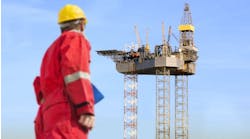Atomic dielectric resonance scanning takes to the seas
Gordon Stove
Adrok
Atomic dielectric resonance (ADR) scanning is moving to the seabed. Adrok believes its approach can cut offshore drilling cost 70% by reducing the number of wells needed. Having established that the technology can detect oil when used onshore, the company is developing its equipment for offshore use to survey the seabed and below for hydrocarbons by mounting a scanner on an ROV and on a small survey vessel.
The scanner's potential includes quantifying reserves, providing insights into the mix of sand and water, mapping geological structures to a higher resolution, and undertaking scans of large remote areas.
The new approach advances physics and has a competitive advantage for the oil and gas industry. Adrok is providing oil and gas exploration companies, including BG Group and Caithness Petroleum, with the capability to pinpoint hydrocarbons.
ADR sends a narrow beam of energy into the ground using micro and radio waves. The depth penetration of this energy is greater than conventional methods. ADRS does not rely on interpretation or probability.
ADR has been used commercially at depths down to 4,000 m (13,123 ft) and experimentally to 7,000 m (22,965 ft). However, Adrok is confident that the current ADR technology will work down to 20,000 m (65,671 ft) and plans to confirm this through further testing. Theoretically the beam can penetrate to 60,000 m (196,850 ft).
Oil and gas application
For the oil and gas industry, Adrok uses ADR to generate a virtual well log, i.e. information equivalent to that derived from a drilled and logged well.
Presently the output takes the form of:
- Spectrometric material classification of subsurface layers; e.g., virtual log providing material classification
- Dielectric log showing dielectric permittivity curves
- Image of the subsurface; e.g., profile scan (two-dimensional cross-section)
- Dielectric and virtual logs output is in ASCII format, to allow the client to input these measurements into their own software models of the survey site(s). Work is under way to produce results in formats which will be familiar to petroleum geoscientists, e.g. equivalent to a suite of well logs.
Firth of Forth
Cairn Energy, an Edinburgh-based oil and gas exploration and production company, witnessed Adrok's offshore trial in the Firth of Forth off Scotland. ADR surveys were made to determine the lithologies of rocks in the subsurface and to accurately measure depths to particular geological horizons to evaluate against nearby drilled locations.
The equipment used in the Firth of Forth was operated from a small barge vessel.
Firth of Forth-1 well was drilled offshore Fife in 1990 through Lower Carboniferous strata overlain by 10 m (33 ft) of Tertiary rocks. The Tertiary rocks, being soft and highly saturated with water, had dielectric constant (DC) values as high as 45. A total of 14 known coals in the upper section of the Carboniferous were all identified as having DCs in the range of 13 to 22. A number of sandstones were recorded on the composite log as having oil shows. These were found to have DCs with reduced values of 4.35 to 5.51, indicative of hydrocarbons.
Following ADR work for Caithness Petroleum in Morocco, Caithness contracted Adrok in 2009 to conduct ADR surveys at three onshore sites in Midlothian, Scotland. The three onshore sites included:
- Cousland, near Dalkeith
- Joppa seashore, Portobello, near Edinburgh
- Newton House, near Dalkeith.
The rocks at all the sites are Carboniferous, ranging from the Coal Measures down into the Lower Carboniferous. A range of documented lithologies are present including sandstone, shale, limestone, dolomite, coal, and volcanics.
The geology of these four areas has been known for many years, so the ADR tests were not blind. Rather, this was important to confirm the validity of the ADR technology.
In these surveys no cores or cuttings were available for typecasting. Adrok used the dielectric constant determined by ADR to find the depth to particular horizons, and also to identify gas and oil shows and lithologies.
In Cousland, the ADR survey was within the mapped area of the gas field which was abandoned in the 1960s. Adrok had the summary log and other data from the field taken in the past by BP, including the stratigraphic positions of five gas-bearing sandstones and several oil bearing sandstones. The survey took place along a north-south traverse over the gas field area and about 50 to 100 m (164 to 328 ft) away from the Cousland-1 gas well.
Firth of Forth equipment at sea.
The Cousland gas field occupies an anticlinal structure on the eastern margins of the Midlothian coalfield. At surface is the Visean-aged Blackhall Limestone of the Lower Limestone formation (LLGS). The LLGS is underlain by the Aberlady formation in which the gas-bearing sandstones were found.
Stratigraphy of Cousland-1 well was as follows:
- Surface to about 113 m (371 ft) Lower Limestone formation (LLGS)
- 113 to 889 m (371 to 2,917 ft) Aberlady, previously called the Oil Shale Group, of the Calciferous Sandstone series.
From surface to 113 m, LLGS is two thick limestones separated by a 12-m (39-ft) thick sandstone. DCs for the limestones in the section from surface to 28 m (92 ft) were 4.38 to 6.07. It is likely that these values can be attributed to weathering effects on the limestone over many millennia. Water draining through limestone would cause dissolution cavities, leaving spaces filled with air which would reduce the dielectric constant. Limestones below 113 m tended to be protected by impermeable shaly strata. Hence, the deeper limestones have dielectric constants that range from 7.81 to 8.9, which is more typical for this lithology. The sandstone from 56 to 68 m (184 to 223 ft) had high DC values, between 12 and 13. These values are attributed to the sandstone being saturated with ground water. At deeper levels, DC values for sandstones decreased to around 10, which is interpreted here as indicating that the sandstones are partly wet.
The depths of five gas sands determined by ADR were extremely accurate and the corresponding DCs were very low.
Three "oily sands" were encountered at Cousland-1. The likelihood is that these sands had reasonably good oil shows though insufficient for production.
DCs for lithologies interpreted as shales in the upper part of the ADR survey, i.e to depths about 164 m (538 ft), were high, in the range 8.5 to 9.5, corresponding approximately to the section where the DCs of the sandstones also were high. This is interpreted as due to high water saturation. At deeper levels, shales DCs were close to normal at 6 to 6.8. The shales having DCs between 5.2 and 5.95 at 245 to 342 m (804 to 1,122 ft), coincided with the descriptions of bituminous shales that contained thin oily sandstones at the Cousland-1 well.
Results
The results obtained applying ADR technology in Scotland can be summarized as follows:
- A variety of lithologies including sandstones, shales, limestones, dolomite, and coal were identified in the subsurface
- The pronounced effects of gas and oil on the dielectric constants of sandstones was demonstrated as were the effects of high water saturation in clastics and coals at Joppa, at Newton, and in the Firth of Forth-1 well
- Accurate depth measurements to particular geological horizons.
How ADR works
ADR technology uses electromagnetic radiation as resonating transmitting and receiving beams of energy.
Maser beams are well known. They are coherent beams of electromagnetic waves at microwave and radio frequencies. They are the longer wavelength equivalent of lasers. Adrok has developed a unique broadband pulsed coherent directional maser beam with properties which give the beam the ability to penetrate solid objects and highly conductive materials to great depth.
The equipment establishes a resonant signal to the required depth. Adrok's hardware/software automatically records key information such as the amplitude and time settings. (Adrok designed and built timing systems which measure to picoseconds with femtosecond jitter). Outgoing and returned signals are given accurate time stamps to enable accurate depth measurements.
There are two different types of scan that ADK acquires at each scan line:
- P- Scan produces an image of the subsurface (from ground level) based on the two-way travel time from transmitter to receiver
- WARR scans — wide-angled reflection and refraction scans used to triangulate accurate depths. The WARR data converts the P-Scan time-stamps into depths in meters. It produces a 2D cross-sectional image of the subsurface.
Scanner's beam
The scanner illuminates the ground by transmitting and receiving lased light beams of electromagnetic energy that are pulsed, coherent (over a narrow band of frequencies), confocal (cylindrical shape), radiowaves/microwaves, resonant frequencies, and that seem to show minimal dispersion. ADR is not an EM resistivity technique; it measures dielectric permittivity of the subsurface, not the electrical resistance of the ground.
The transmitted waves have two components: a long wavefront standing wave to get deep penetration; and a shorter resonance waves within the standing wave to enhance vertical resolution.
Adrok can setup the long waves to penetrate to 1,000 m. The shorter resonance waves will pick up fine rock horizons as thin as 1m up to the depth of 1,000 m.
ADR accurately measures the dielectric permittivity of materials encountered and determines the dielectric constant of each layer of rock. The dielectric constant is basically the effect that a given material has on slowing down the ADR signal. Determining the dielectric constant of each layer enables each rock layer to be mapped as with seismic but more accurately. ADR transmits and receives its signals based on the speed of light (an order of magnitude faster than the speed of sound used for seismic imaging).
Dielectrics also allows preliminary identification of the composition of each layer e.g. limestone, dolerite, or sandstone.
The ADR scanner measures depths to each subsurface horizon that gives a reflectance and change of beam velocity. Two independent methods are used to calculate depths to each horizon: 1. Normal move out (NMO), and 2. Ray tracing. Only when both methods give the same depth measurement does the software accept that depth reading (this is called parallax). Adrok's depth measurements can be used to help tie-in or improve depth measurements made by seismic tools.
The most important result of ADR's ability to penetrate all materials is that all the imaging techniques of spectrometry become available to identify all materials encountered subsurface. Identification of these materials is based upon:
- Absorption and reflection and emission of different wavelengths of electromagnetic radiation
- Relationships of components in the returned signals e.g. energy/frequency/phase relationships.
After the subsurface has been divided into its geological horizons by determining its dielectric constant, spectrometry is used. When ADR encounters an unknown material in the subsurface, it compares the return signals from that material with its data base of known typecast materials until it finds a match, thereby identifying the material.
Offshore Articles Archives
View Oil and Gas Articles on PennEnergy.com





